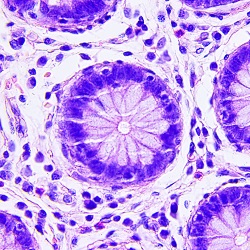Researchers in Barcelona report progress in the use of 3D organoid technology to create an analogue of human colon cancer in a mouse model.

Amsbio products were used to create 3D organoid model for colon cancer
The study, from the Institute for Research in Biomedicine (IRB), shows that the hormone (transforming growth factor beta, or TGFß) is responsible for the ‘blindness’ of the immune system to colon cancer cells.
It is this blindness that allows cancer cells to proliferate, without being attacked by the body’s immune system.
Therapies which stimulate the immune system have become a powerful approach to treating cancers such as melanoma and lung cancer, but so far most colon tumours have been unresponsive to this type of therapy.
The IRB Barcelona scientists developed the animal model and confirmed the similarity of the mouse tumours with those in humans.
They then built a biobank of tumour organoids (3D mini-tumours) to graft them into immunocompetent mice.
This allowed them to examine how cancer cells evade the immune system through increased levels of TGF-beta, and paves the way for the development of TGF-beta directed immunotherapies for patients diagnosed with advanced colon cancer.
“The ability to culture and maintain tumor organoids has been key to the success of this research” said professor Eduard Batlle, ICREA group leader at IRB Barcelona.
“Organoids, as provided by Amsbio, offer multiple advantages as pre-clinical models for cancer research and drug testing”.
The report, published as a letter to the journal Nature, can be viewed here (PDF, 10Mb):
http://www.ngmbio.com/file.cfm/82/docs/Tauriello_2018_Nat_TGFb_CRC.pdf
Amsbio‘s range of matrices and 3D cell culture products include natural hydrogels, recombinant matrices, artificial scaffolds, and scaffold-free systems.
These matrices not only support cells and cell layers, but play an essential role in tissue organisation affecting cell adhesion, migration, proliferation, and differentiation.
Amsbio also offers ready-to-use cells for in vitro T-cell mediated target tumour cell killing and assessing the activity of immunotherapeutic agents.
